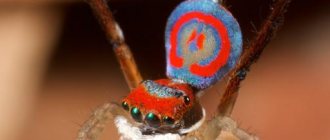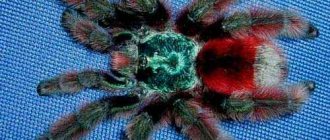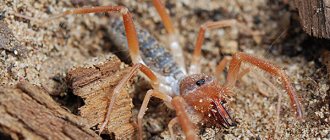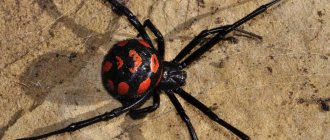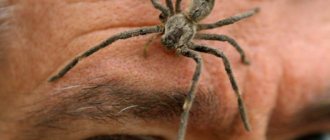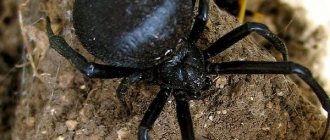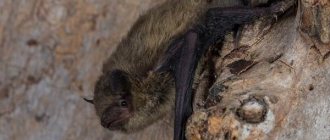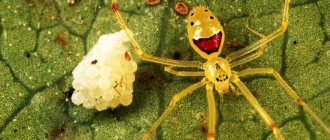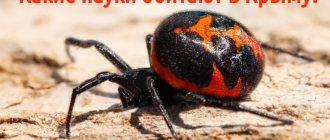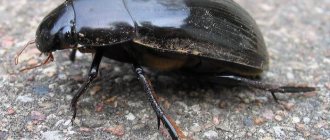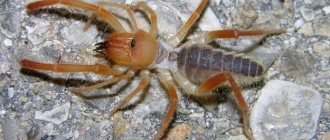The unique climate and landscape of the Crimean peninsula has always attracted tourists. Some people prefer to relax in comfortable rooms and only occasionally go on walks to explore the surrounding area. Others, like the heroes of the film “Three Plus Two,” blithely climb away from civilization and enjoy sandy beaches, mountain landscapes or steppe expanses around the clock. However, not everyone knows that the spiders of Crimea can pose a serious threat to humans and getting to know them can end very badly, even leading to death.
On a note! The subtropical Crimean climate is a favorable environment for the development of poisonous arthropods. With the onset of abnormal heat, they become more active. Every year, dozens of people are admitted to Crimean hospitals after being bitten by spiders.
Dangerous spiders that are found in Crimea
Let's look at what arthropods you should be wary of and what to do if you are bitten by a poisonous spider.
Tarantula
Tarantula is the largest representative of arachnids in Crimea. Its dimensions are more than 3 cm in length. Inhabits the arid regions of the steppe part of the Crimean Peninsula. During hot weather, it hides in a hole, the depth of which can reach half a meter. The Crimean tarantula feeds on beetles, insects, caterpillars, and grasshoppers. The tarantula does not attack first, but, on the contrary, hides in a hole, barely catching the vibration of the earth.
Note : a tarantula bite is not dangerous to human life. The sensation is comparable to a wasp sting. The bite site swells, but over time the swelling goes away.
Salpuga (phalanx spider)
The salpuga spider is not inferior in size to the tarantula. Its yellowish-gray color and long legs are terrifying. Lives in the foothills and on the South Coast.
Important ! The danger comes from a large spider that can bite through the skin. A small spider cannot do this.
A salpuga bite causes a burning pain that soon goes away. The arthropod is not poisonous. The main danger lies in the fact that the spider's chelicerae store the remains of its diet - rotting particles of the flesh of its victims. When bitten, they enter the bloodstream and can cause infection and inflammation of the bite site.
Karakut (black widow)
The most dangerous spider of all that lives in Crimea is, of course, the Black Widow - a spider whose habitat is tall, dry grass. The male karakuta grows up to 7 mm, the female is slightly larger. A distinctive feature is four red dots on the back. After mating, the female devours the male, hence the name.
Need to know! A black widow's bite can be fatal. The venom of this arthropod is 15 times stronger than the venom of a rattlesnake. However, when biting, the spider does not inject the entire dose into the victim’s body, but only a part. Thanks to this, the victim manages to survive.
Bite symptoms:
- increasing pain with a growing effect
- dizziness
- numbness of the limbs
- panic fear
- vomit
- convulsions.
What to do if you are bitten?
No later than two minutes after the bite, you need to burn this place with a hot match. This must be done quickly, before the poison spreads throughout the body.
Agryope spider
This spider grows up to 1.5 cm. Because of its color, it is often called the wasp spider or zebra spider.
Agriopa's venom is not life-threatening , but the bite itself can cause a lot of trouble. Allergy sufferers and people with weakened immune systems can especially suffer from it. In some cases, an abscess may form at the site of the bite, accompanied by further tissue necrosis.
Symptoms of an agriope bite:
- sharp burning pain, like a bee sting
- immediate swelling and redness of the skin area
What to do?
No first aid required. Particular attention should be paid to children and allergy sufferers. If you feel worse, you should seek medical help.
This is interesting: Recreation center "Parus" in Popovka (Crimea): official website, reviews, description
Scorpion
An endemic species of scorpion lives in Crimea. It is very small, only 35-40 mm long. The color is light yellow, the claws are brownish. Meeting him is a great rarity and, rather, luck than misfortune. After all, its bite is not fatal. True, it causes poisoning of the body. When bitten, a very strong pain is felt, the place immediately swells. Weakness of the body, decreased pulse rate, and sometimes headache, vomiting, and suffocation may occur. In this case, you need to take anti-allergy tablets and treat the bite site with vinegar or fresh tomato. Doctors say that after these measures, in principle, you can do without their services.
By the way
Snake and insect experts say that when a person is bitten by any animal, the main enemy is not poison, but panic. It is this that, firstly, prevents a person from assessing the situation and taking the first measures, and secondly, panic helps make already unpleasant symptoms seem twice as painful and scary. Many, for example, lose consciousness not so much from the bite itself as from horror. Therefore, experts advise, paradoxical as it may sound, not to panic: after all, a fatal result for our latitudes is very rare.
Do you know that…
According to the Guinness Book of Records, the Brazilian wandering spider is considered the most poisonous spider in the world. This spider got its name because it does not sit in one place and does not weave webs, but actively moves in search of food. It eats insects, other spiders, birds and lizards, and is also very fond of bananas.
Some specimens of this spider are so dangerous that human death can occur within 20-30 minutes if immediate help is not provided.
Karakurt - a poisonous inhabitant of Crimea
The karakurt is recognized as the most dangerous representative of spiders. It feeds on insects. Favorite habitats are rodent burrows, from which the spider easily expels the inhabitants. Even if the mouse decides to resist the karakurt, it instantly dies from its bite. Also settles between stones, in rock cracks. It places its trapping nets in the grass, in the steppes and even in summer cottages. From Turkic the name “karakurt” is literally translated as “black worm”; a photo of the dangerous spider of Crimea is presented above.
What does the most dangerous spider in Crimea look like:
- Sexually mature females are rich black in color with a glossy sheen, up to 2 cm long.
- The length of males does not exceed 7-8 mm.
- Juveniles and males have 13 red spots on the abdomen. Sometimes they are framed with a white border.
- Two pairs of eyes help to navigate well during the day and at night.
- Random networks are located mainly near the ground.
Karakurts are very prolific. Periodically, at intervals of 10-12 or 25 years, there is a massive outbreak of population growth. They spend winter time in cocoons, several of which are suspended in nests. In mid-spring, the young generation appears and is carried away on the web by the wind. At the end of June, having become sexually mature, females and males look for shaded places and weave nets for mating.
Interesting! Due to the bloodthirstiness of the female during mating, the karakurt is also called a black widow. The mating games of the female are very peculiar - at the end of the process, she eats the male. The female has an excellent appetite: her network for mating can simultaneously contain up to 5 candidates.
The males' life cycle ends in mid-July. After mating, females look for new places, weave a network and lay offspring. After the last laying of eggs they die.
How karakurts bite
Representatives of the black widow genus are not characterized by aggressiveness towards humans. Only if they sense danger do they defend their lair - only in emergency cases are they able to attack people. Most often, this type of spider in Crimea bites accidentally. This is due to the peculiarity of their reflexes. When pressed on the abdomen, they release poison; for this reason, a spider crawling on the body should not be slammed, but carefully thrown off.
The greatest threat to humans is the female karakurt, while males, due to their small size, are not able to bite through human skin
On a note! After picnics or trips to nature, it is recommended to inspect things, as spiders can easily get into them. It is best to walk through thickets of grass in closed high shoes, and to work in summer cottages and fields with gloves.
The concentration of poisonous components in karakurts is 15 times higher than in a rattlesnake. This feature is due to the fact that spiders wage a constant fight against rodents and other small mammals, and to neutralize them a strong poison is needed. In humans, the probability of death after a bite is 2-4%. The poison has a neuroparalytic effect.
Symptoms of a karakurt bite:
- the appearance of severe burning pain, which intensifies and spreads throughout the body within 15 minutes;
- difficulty breathing;
- dizziness, possible bluish discoloration of the skin on the face;
- disturbances of heart rhythm and kidney function;
- cramps, muscle spasms in the abdominal area;
- depressive state, the appearance of a feeling of irresistible melancholy and fear of death.
On a note! The sensations of the bite field depend on the person’s pain threshold. There are cases when people in a dream did not notice at all that they had been bitten by a spider.
What to do if you are bitten by a karakurt:
- The most effective way to eliminate the consequences of a bite from the most dangerous spider in Crimea is to administer a serum. However, it is not always available at medical centers. In its absence, an intravenous injection of potassium manganese or calcium gluconate is administered. The need for a second injection is determined by the condition of the victim.
- In the field, the cauterization method, which was developed by Marikovsky, is used. Immediately after the bite, in order to neutralize the effect of the poison, 3 matches are applied to the wound (heads to the wound), and the fourth is set on fire. High temperature destroys the protein structure of the poison and thereby avoids poisoning the body.
Signs and superstitions
Hermit spiders, like the rest of their relatives, are associated with many signs and superstitions.
It is believed that the spider that lives in the house completely absorbs the negative energy accumulated in the corners. People have long believed that trouble and misfortune await a family that kills a spider.
The house in which the spiders settled was considered rich and happy. The belief is based on a reasonable explanation: arthropods prefer to live in dry and warm rooms. A wealthy farmstead is characterized by the creation of suitable conditions for spiders to live.
They also try to link the behavior of arthropods to signs:
- if you are hiding, expect rain;
- In warm, dry weather, spiders actively build webs, catching your eye more often.
If an arthropod is found in an uncharacteristic habitat - the bathroom - this is associated with expected problems in your personal life or financial losses.
Many people attach importance to the direction of movement of the animal in relation to the person. If the arthropod moves towards you, good news is expected, otherwise bad news.
Spiders in dreams
In dream books, the spider acts as a key figure determining the destiny:
- Gypsies believed that dreaming about a spider meant great luck;
- Miller's dream book - to career growth, a large cash bonus, positive assessment from management;
- according to Vanga - to scandals, serious disagreements;
- the Spaniards believe that arthropods dream of a loss of reputation associated with a scandalous story, a meeting with an ill-wisher;
- French belief - to treason.
https://youtube.com/watch?v=wjEnV1UeGD8
Despite the various interpretations of beliefs and superstitions, the hermit spider is a dangerous animal for humans in direct contact. Therefore, reasonable preventive measures and knowledge of the animal’s behavioral characteristics will not hurt in order to protect yourself from undesirable consequences.
Tarantula. Crimean tarantula. Tarantula bite, help with a bite.
Tarantula is the common name for several species of large spiders belonging to the wolf spider family. Tarantula is an invertebrate animal. Its body, consisting of two parts - the cephalothorax and abdomen, is covered with small hairs. Tarantulas are the largest spiders living in Ukraine, the size of large individuals reaches 4 cm. The spider is colored brown-gray-black, and those that have not shed for a long time have a red tint. Very often, other large spiders, such as tarantulas, are mistakenly called “tarantulas.”
Read more…
What insects live in Kuban
The Krasnodar region is rich in fauna. Many different insects live there. Some representatives are dangerous. The table shows the main individuals.
| Narynivnik | It's a bug that bites. The bite site begins to swell. A large blister appears. The insect has a rich color. This informs other fauna that it is toxic and potentially dangerous. You have to be careful. An animal or child who eats a beetle can die instantly. It will be practically impossible to prevent death. There are dark spots on the body. In appearance, the representative vaguely resembles a ladybug. |
| Scolopendra ringed | Large creature. The centipede has a poisonous jaw. The representative prefers dark and humid places. The insect is poisonous. The bite site swells. Lymph nodes swell. The body length is 15 cm. The poison affects the composition of the blood. Pain at the site of the bite persists for several days. The insect often settles in human dwellings. |
These are the main poisonous representatives of the Krasnodar region.
Let's put a cross: biting cross spiders
In many spiders, females are dangerous to humans - they are significantly larger than males (they are simply unable to bite through the skin). This is also true for cross spiders. There are several varieties of them (common Araneus diadematus, diamond-shaped), but they are all similar in habitat, appearance and influence on people.
Krestoviki weave trapping nets and hang them between trees and bush branches. All of them are not rare; many have seen them. A distinctive feature is a light pattern like a cross on the abdomen. These are large spiders - a female, hanging with her legs spread out in the web, can reach 4 cm in “diameter”. They feed on insects.
A cross bite is not dangerous, but can be painful and cause significant local inflammation (up to and including slight necrosis of the tissue around the wound). No special treatment is needed - just lubricate the area with anti-inflammatory agents. If the manifestation is severe, you can take an antiallergen.
This is interesting: Mount Perchem in Sudak (Crimea): photo, how to get there, on the map, description
Habitat
Mink places are rural and suburban areas, hills, fields. He is often a dangerous neighbor to people. The depth of planting potatoes is equal to the depth of the hole. While collecting culture, you can stumble upon the shelter of an arthropod.
Mizgir prefers desert, semi-desert and steppe climates. This species is distributed over a wide area. Most favorite regions:
- Asia Minor and Central Asia;
- south of Russia;
- Ukraine;
- south of Belarus;
- Far East;
- Türkiye.
Scolopendra. Features of the Crimean scolopendra. How to protect yourself from Crimean centipede.
Scolopendra is an armored centipede that looks like a long, dark brown worm, sometimes with a greenish tint. It mainly lives in tropical countries and only a few species are content with a temperate climate. In Crimea there is a ringed scolopendra, reaching 12 cm in length. The Crimean scolopendra loves dark and slightly damp places, hiding under stones, in cracks in the soil, under old trees. During the day it leads a secretive lifestyle, but after sunset it goes out hunting. I must say that this centipede is an excellent hunter! The scolopendra grabs the victim with its front legs, and then plunges its poisonous jaws into it. Eats very slowly. The diet of the Crimean centipede consists of various insects, beetles, larvae, arachnids, and does not disdain mollusks. On hot sunny days, food often finds itself to the hunter, who hides from the sun in a cozy hole or crevice.
Read more…
Ground beetle - consumer and destroyer: varieties
Different types of beetles have distinctive abilities. Some of them have three eyelids, others two. Larval development takes place within three weeks in small species and up to several months in large ones.
Predatory beetles become especially active at nightfall, while during the day they camouflage themselves in the shade of plants. Insects become especially active in cloudy weather.
According to the type of seasonal activity, beetles are divided into:
- spring-autumn;
- spring-summer;
- summer
The first, spring-autumn ones, demonstrate increased activity precisely in the spring-autumn period. Spring-summer representatives of beetles are active in spring and summer; accordingly, summer is the optimal time of year for summer ground beetles.
Various peaks of activity in beetles primarily depend on the frequency and characteristics of reproduction.
In addition to seasonal activity, the ground beetle (the photo below will not allow you to make a mistake) in the category of obligate predator is divided into several small species:
- purple;
- golden;
- emerald;
- shiny, etc.
Each of them has its own description, which allows you to distinguish the insect from the rest. For example, the emerald beetle in adulthood can have a body from 2 to 8 cm long. Insect larvae are distinguished by their elongated elongated shape; they are mostly predators, in some cases herbivores.
The emerald ground beetle pupates in the soil. It feeds mainly on the larvae of other insects, worms and mollusks. Some of their representatives happily feast on vegetation under stones or boards. These types of beetles are found in different parts of the world, do not harm humans, destroying many harmful insects in the garden. A distinctive feature of the caterpillar is its bright color with a pearlescent tint.
Traditionally, the golden ground beetle is found in European countries, Russia and some countries of Central Asia. The beetle feeds on the gypsy moth, one of the garden and vegetable garden pests.
The body length of an adult reaches 30 mm, the body color is green or bronze with a hint of gold. The lower part is black, the front is a bright greenish hue. The beetle's favorite soils are sandy-clayey soils; it lives mainly in gardens and fields, as well as in meadows and arable lands. The beetle larvae camouflage themselves under stones.
Sources
- https://BeetleStop.ru/pauki-kryima/
- https://fb.ru/article/261630/jujelitsa-kryimskaya-pitanie-i-obraz-jizni
- https://givotniymir.ru/zhuzhelica-nasekomoe-obraz-zhizni-i-sreda-obitaniya-zhuzhelicy/
- https://poluostrov-krym.com/nashkrym/zhivotny-mir/nasekomye-kryma.html
- https://fb.ru/article/167218/kto-takaya-jujelitsa-kavkazskaya
- https://trekequip.ru/bezopasnost/jivotnie/yadovitye-pauki.html
- https://klopkan.ru/sad-ogorod/zhuzhelitsa-sadovaya/
How to protect yourself while hiking. Simple rules
Be especially careful in the evening and at night, when arthropods are most active. Try to walk in closed shoes. When collecting wood for a fire, first turn over branches or sticks with your feet to make sure that no one is under them.
Boots. Try not to leave your boots outside the tent overnight. If you don't feel comfortable with them in your tent, hang them from a tree or tuck a sock into the top. Be sure to shake them out in the morning. Tent. Treat the entrance to the tent with repellent. At any time of the day, the entrance to the tent must be closed with a zipper. Sleeping bag. Before going to bed, shake out your sleeping bag. Cloth. If clothes have been left outside for some time, it is also a good idea to shake them out. Medicines. Carry antihistamines with you in case of an allergic reaction from a bite.
Now you know about all the potentially dangerous inhabitants of Crimea. If reasonable precautions are taken, the risk of threat to life and health is minimal.
Do not forget that the most poisonous on the Crimean peninsula is karakurt, the poison of which is several times stronger than the poison of a rattlesnake. The bite of other arachnids in Crimea is not fatal and does not pose a serious danger to a healthy person, but allergy sufferers, children and people with weakened immune systems remain at risk.
Emergency care for snake bites and farts. Video from Dr. Komarovsky
When to see a doctor
- a child or a person weakened by illness is bitten;
- the state of health of the bitten person deteriorates sharply;
- an allergic reaction began: severe pain and swelling, a rash around the bite site.
Experienced tourists, when bitten by a tarantula while hiking, take a break for several hours, when the symptoms are most severe, and then continue the hike. But these are people who are already familiar with the spider and are ready for all sorts of consequences. It's better to go to the hospital.
There are millions of people in the world who suffer from arachnophobia, that is, the fear of arachnids. And their fears are not groundless: although most of them are completely or relatively safe for humans, among them there are those that threaten life. Spiders of Crimea do not graze their hind legs - in the fauna of the peninsula there are a number of poisonous representatives of eight-legged species, which we will talk about today.
Solpuga - an inhabitant of the southern coast
Salpugs, also known as phalanges, are another interesting species of spider in Crimea, listed in the Red Book. They live in arid areas, mainly in the foothills of the southern part of the peninsula. They are active at night. The body length can reach 5-7 cm. The entire body and paws are covered with hairs. The forelimbs resemble tentacles. They feed on insects, small lizards, and scorpions. The structure of compound eyes, which provide instant reaction and visibility in the dark, makes salpugs excellent hunters.
Salpugs are very mobile, run well and even jump high
In South Africa, such arachnids are called barbers. This name stuck due to the developed strong front tentacles, through which they are able to deprive a person of hair on his head, as well as animal hair. Spiders line the bottom of their nests with “cut” hair.
Small individuals cannot harm humans, since not yet fully formed chelicerae are not able to bite through the skin. But a meeting with an adult spider does not bode well. Their chelicerae are equipped with teeth and their bites are very painful. And although the spider does not inject venom when it bites, its jaws retain the remains of previous victims, which can penetrate the wound and cause rotting. It is noteworthy that salpugs are not afraid of people and can easily join gatherings near the fire.
Low-venomous spiders
Since non-venomous spiders do not exist in nature, there are none in Crimea either. There are species that, when large in size, are not dangerous to humans, since their venom is too weak or the chelicerae cannot bite through the skin. Some spiders, for example the haymaker spider or the house spider, are completely unable to catch human skin. Small spiders sitting in the grapes hunt insects in the grapes that have decided to feast on the berries. Since Crimea is one of the regions where grapes are grown on an industrial scale, such grape spiders have freedom there.
These little spiders may scare only arachnophobes. But large spiders with striking bright colors are able to alert any person who is not familiar with them. Such spiders in Crimea include:
- Argiope Brünnich;
- Argiope lobata;
- cross spider.
Because of their coloration, argiopes are considered dangerous spiders. The cross can be intimidating only by its size.
Argiope bruennichi
Argiope is also called the wasp spider because of the color of its abdomen. Argiopes are classified as orb-weaving spiders that build webs on trees and shrubs.
Argiope Brünnich
The spiders are small in size: females up to 1.5 cm, males up to 5 mm. In both sexes, the abdomen is colored with black and yellow transverse stripes. But the female has a rounded abdomen. The male's body shape is indeed very similar to a small wasp. These are arthropods common to the Crimea, but the population is not as large as that of the crosses.
The bite of the argiope is quite painful. But it causes only short-term pain and local irritation at the bite site.
Argiope lobata
Another species that is found in Crimea in small quantities. When you look at the spider, you get the impression that it is dressed in a hard chitinous shell. But this is deceptive. In fact, Argiope lobata has the same soft abdomen as other spiders. It looks like an armored monster due to the silver-white color of its abdomen, “equipped” with 6 deep notches on the sides. The color of the notches can range from dark to orange.
The female’s body size is up to 1.5 cm. Lobata builds nets on trees and bushes. The poison is not dangerous to humans, although the bite is unpleasant.
Common cross (Araneus diadematus)
The most common large spider in Crimea. You can come across his nets everywhere: from tall grass in the steppe to a tree on a Crimean yaila. Krestovik loves to settle in vineyards and gardens. There's more loot there.
Spiders of Crimea
The female's body size is 2-2.5 cm, the male's is 1 cm. The female has a large, convex egg-shaped abdomen with an exaggeratedly sharp tip. The “blunt” end of the “egg” is connected to the cephalothorax. The male has a “flattened” abdomen, elongated and narrow. The cephalothorax is round and wider than the abdomen.
The color of crosses can be yellow-white or gray-white. On the back there is a characteristic pattern in the form of a cross, for which the spiders received their name.
On a note!
The bite of the cross is weaker than that of a mosquito and is not capable of causing harm. The spider cannot even bite through the skin of a 6-year-old child, but it is able to explain to the mischievous child that there is no need to hunt funny “crusaders.” Crosses are dangerous only for people with a tendency to allergies and those suffering from arachnophobia.
Harmless
The following families are very common in Belarus: funnelbirds, hunters, sidewalkers and horses. Besides them, you can find 4 species of wolf spiders there. Apart from family and protective coloration, these night hunters have nothing in common with the South Russian tarantula, which is also a wolf spider.
Funnel
Funnelfish live in moist, shaded places, on the forest floor, under snags and at the foot of bushes. They often settle in village houses. People gravitate toward human habitation:
- funeral;
- brownies;
- attics.
Hunters
They live on the banks of reservoirs, of which there are plenty in Belarus. There are only 3 pisaurid spiders found in the country. Spiders hunt with their hind legs on coastal vegetation and their front legs on the water surface. These hunting spiders can glide across the surface of a body of water like water striders.
Horses and sidewalkers
Jumping and side-walking spiders are inhabitants of meadows, forest clearings and agricultural fields. Most often, these arthropods sit in ambush on grass or leaves of bushes. They catch small insects that fall within their reach. These small animals pose no danger to humans.
Argiope: eight-legged wasp
Argiope (Agriope bruennichi) is a large spider, comparable in size to cross spiders. He is beautiful - information for those who can generally see beauty in such animals. Its mode of existence is similar to the little cross, only the first one more often hangs its mud in the grass. It has a characteristic black and yellow stripe color, like a hornet, which is why it is popularly called the wasp spider or “zebra”. Several subspecies of Argiope are found in Crimea.
Argiope is not life-threatening, but can be frightening - its resemblance to a flying insect is enhanced by the sensation of a bite. It bites painfully and usually unexpectedly (in thick grass it is harder to notice than you might think).
Inflammation occurs - exactly the same as in the case of a wasp sting. The difference can be determined by looking closely at the punctures - the wasp leaves one, and the spider leaves two. The treatment is also “anti-wasp” - lubricate it with something anti-allergic. In the vast majority of cases, pain, redness and swelling appear quickly, but after a couple of hours they completely disappear on their own.
Tarantula in Crimea: a serious matter
The South Russian tarantula (Licosa singoriensis) was recorded in Crimea only in recent years, but during this time it managed to become trivial on the peninsula and cause a lot of trouble. He is a burrowing, steppe animal, lives in dry areas (in the region of Kerch, Evpatoria), where there is vegetation, and digs holes in the ground (or engages in raider seizures of mice, and kills the owners). The spider does not weave webs - it waits in the hole for the prey to approach, and then with a sharp throw it pounces on it and paralyzes it with its bite. Spiderlings that hunt in this way are called “wolves.”
They are gray in color, shaggy - this can be seen if you look closely, with powerful legs. Yes, these are the largest spiders in Crimea. Their body length sometimes reaches up to 3 cm, with outstretched legs twice as long, but they rarely take this position. The females guarding the cocoons are especially dangerous (they look exactly like cocoons, only with a rather non-standard weave). They often climb into the tents of inattentive tourists.
Tarantulas are dangerous animals. In Italy and Spain in the Middle Ages, it was believed that the only way to survive after their bite was to dance a grueling dance for a long time (yes, this is how the famous tarantella appeared). In fact, it is quite difficult to die (although it is possible with an enhanced reaction). But significant pain, swollen lymph nodes, nausea, rapid heartbeat, fever and difficulty breathing are traditional.
The victim is advised to drink plenty of fluids and take an antihistamine (the sooner the better). Immediately after contact, the wound can be cauterized (with gray from a match head). A spider is not a snake; it pierces the human body only a couple of millimeters, so the procedure will be both effective and not too painful. But tourniquets cannot be applied. If the reaction turns out to be pronounced, you need to fly to the doctor at full speed. Patients with allergies to a tarantula bite can die from cardiac arrest or suffocation.
Biology of the species
Description
Let's start the description of the karakurt spider with its size. The species has clearly expressed sexual dimorphism, in which the female has a leg span of twenty millimeters, and the male is only 5-7!
Look at the difference between the sexes in the photo of a male and female karakurt.
Distribution area
Naturally, having heard about dangerous bites, every person is interested in where the karakurt lives. This representative of black widows prefers forest-steppe, steppe and semi-desert zones with a warm climate. Therefore, its habitat is in southern Europe, Central Asia and northern Africa.
As for the post-Soviet space, the black widow is found in Azerbaijan and Kazakhstan. In the Azov region of Mariupol, Donetsk region of Ukraine, karakurts were also noticed not so long ago.
In Russia, karakurts are also very widespread. This mainly applies to the southern regions of the country and those regions located in the steppe zones. For example, karakurts are often found in the Crimea and the Rostov region, in the Novosibirsk region and the Altai Territory.
In addition, scientists have recorded cases of catching karakurts even at the latitude of the Moscow region, which occurs during the migration of spiders in especially hot years. But such appearances are sporadic, since the black widow cannot endure the harsh winters of the central zone of our country.
The black widow's natural habitats tend to be flat. It can be:
- steppes;
- arable land;
- areas near ravines or artificial ditches;
- salt marshes;
- wasteland.
Nutrition
The black karakurt feeds on insects that fall into its nets. These are usually the types of arthropods that live directly next to the spiders themselves:
- beetles;
- grasshoppers;
- locusts;
- flies and horseflies.
It is interesting that the victims of karakurts are caught in horizontally stretched nets. At the same time, the web of karakurts is not distinguished by the grace of circular lines, but is made as if randomly, but at the same time it is very viscous and does not give the insect caught in it any chance of salvation.
The spider paralyzes the caught insect with poison and then sucks out its liquid tissue.
Reproduction and development
In the summer, spiders, having found a secluded place, begin mating games. The male karakurt creates a patina by scenting it with his pheromones to attract a female. As noted above, after mating, the male is mercilessly eaten, and the female begins to look for a secluded place to lay a clutch, in which she places up to 130 eggs.
Unlike other types of arachnids, the female karakurt forms from two to four cocoons, into which she lays eggs. For oviposition, she uses rodent burrows or similar secluded places. Here she weaves a web, from which she hangs her cocoons. When the autumn cold sets in, the female dies, having only slightly outlived her eaten husband.
The eggs in the cocoon are reliably protected from the cold and easily endure the winter, and in the spring they begin to fight for existence. In autumn, the wind tears the cocoons from the web, and the clutch begins its journey across the steppe, thus expanding the habitat of the species.
The spiderlings appear quickly, within 10-15 days depending on the weather, but they do not leave the cocoon and live in it until next spring. At first, they feed on the food supply that nature has placed inside their body, then they switch to cannibalism, as a result of which only the strongest individuals are selected from the cocoon.
During spring and summer they grow, living through several molts during this time: males - seven times, females - nine.
Enemies of the Karakurts
It turns out that the formidable black widow karakurt is not omnipotent, and many animals not only are not afraid of it, but are also able to feed on them. The natural enemies of spiders are herd animals. A flock of sheep or a herd of horses can trample entire hectares of steppe along with the spiders living there.
Sphex wasps act against karakurts in their own favorite way: they inject poison under their skin, paralyzing and subsequently killing them.
The wasps lay their eggs in cocoons with spiderlings, and then their larvae easily deal with the unprotected spider nymphs.
Finally, the ubiquitous hedgehogs also love to feast on karakurts; they are not afraid of karakurt bites, being protected by armor made of needles.
Spider from the basement
Poisonous spiders are found everywhere in Crimea. A relative of the tarantula, the cellar arachnid Segestria florentina, is similar in everything to the first, except for the area of residence - it loves dark, rather damp areas, in which you most often do not expect to see such an insect.
The cellar spider is smaller and darker than its counterpart (usually bluish-black or gray-brown), and does not have the characteristic light rings on its legs. You can meet it under stones, in ravines and, naturally, in basements, cellars, vegetable stores, and garages.
The health risk when meeting him is negligible. But muscle discomfort, swelling, numbness of the affected part of the skin, sometimes spasms, increased excitability are common signs. Treatment is anti-inflammatory drugs externally and antihistamines internally. Everything should go away in a few hours.
Among the burrow spiders of Crimea, the black eresus (Eresus kollari) is also dangerous. It is unclear which colorblind person gave it its name, since the striking feature of the spider is its bright red abdomen with four black dots. The bite causes local inflammation and prolonged pain. But eresus are rare and even less likely to emerge from their burrows.
Karakurt or Black Widow. First aid for a karakurt spider bite.
Karakurt, or black widow, is widespread in the steppe part of Crimea. The spider's body is completely black, often with red spots on the abdomen and a white outline around the perimeter. Karakurt has an average size: 4-7 mm - male, 10-20 mm - female. The spider's favorite habitats are virgin lands, river banks, ravine slopes, and wastelands. One of the features of karakurt is their network. Basically, they weave it not vertically, like most spiders, but horizontally. Karakurt loves to settle in the burrows of field mice, in stone rubble, cracks, and dry heaps of old garbage. The spider does not like dense grasses and shrubs, and also does not like high humidity.
Read more…
Lifestyle
Tarantula in people's homes.
South Russian tarantulas have a solitary lifestyle. They only tolerate other spiders when they mate. Males are constantly at odds.
Each female has its own burrow up to 50 cm deep, built as deep as possible. All the walls are woven with cobwebs, and the entrance to the hole is sealed with cobwebs. During the day, the mizgir stays in the hole and watches everything that happens above. Insects get caught in the web and become prey.
